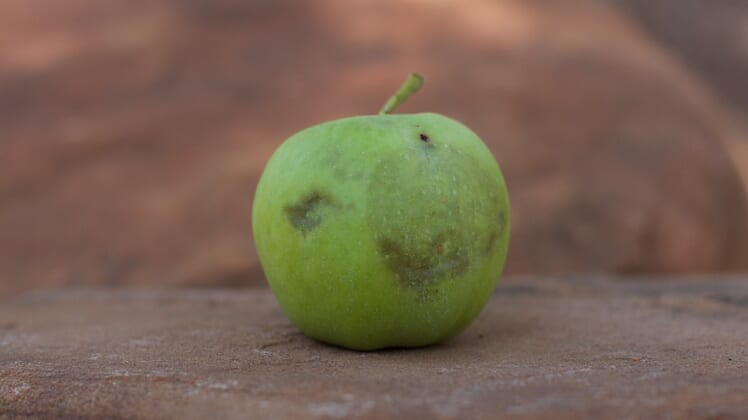
When you look at a bruised apple, slimy cucumber, or brown banana, do you throw them away? Are changes in color or texture really signs of fruits and vegetables going bad?
These reader questions show an uncertainty as to when fruits and vegetables going bad is serious enough to throw away money spent on groceries.
As it turns out, spoilage is not the same thing as bruises on fruit. Microbes constantly try to enter plants in nature because they want the nutrients just like humans do. This is a natural part of the environment, but most bacterias that target plants aren’t bad for humans.
Are bruises a sign of fruits and vegetables going bad?
The answer is yes, but you can still eat them. Bacteria that fight plants in nature and create discoloration or dark spots cannot fight the human immune system in the same way, as TED-Ed explains. Therefore, eating bruised fruits or vegetables will not put you at risk for infection.
Most “mushy spots” on things like peaches or tomatoes come about after people take the fruits and vegetables off of the plant. This is because it is easy for fungi and bacteria to enter the fruit or vegetable after it falls or bumps other things during transport. Furthermore, water-based microbes can get on fruits after the grocery stores wash them for the display.
Bruised areas might not taste great because they represent the cells of the produce that bacteria is slowly killing. However, this does not translate to the human body.
Dangerous pathogens like E.coli can be on fruits and vegetables, but they do not create any visible marks. This type of bacteria can harm humans but has nothing to do with making fruit go bad. As a result, you should be more worried about washing your produce of these bacterias rather than eating brown or bruised spots.
What if there are no spots or bruises on them in the store? How can I prevent fruits and vegetables from going bad in my fridge?
Farms and grocery stores are not the only places where you can see fruits and vegetables going bad. Bruises and brown spots can appear after you bring your produce home from the grocery store as well. This is because your house and refrigerator can lead the fruit to get wet, bumped, and injured by bacteria or bugs. Not only does this make your produce spoil faster, but it can add bruises that a lot of people refuse to eat.
The best way to prevent this is to store produce properly. The Tri-State Fruit and Vegetable Safety Consortium suggests that you only wash fruits and vegetables right before you eat them. Washing them before storage can lead to bacteria, bruises, and mushy spots.
Another factor is knowing which fruits and vegetables need to be stored at room temperature versus in the refrigerator. This also has to do with which fruits and vegetables you can store together. If certain fruits that are meant to last longer lie next to fruits that spoil faster, they might go bad quicker in a shared space.
Environmental impact
Not eating produce because you think you see the fruits and vegetables going bad can lead to serious food waste. Throwing away food wastes the energy and water that farms use to grow the produce. Not to mention, it deprives starving people of perfectly safe foods. Some people throw food away simply because it looks like “ugly” produce, as the Huffington Post writes.
Produce that is thrown away might not even be spoiled, which wastes money and resources. In order to prevent this, it is important to know the difference between spoilage and bruises as shown above.
Next time you see a slightly discolored fruit or vegetable in your grocery store or in your refrigerator, don’t throw it out. Instead, wash and eat it knowing that you are not putting yourself at risk. Moreover, you are helping the environment stay sustainable.
